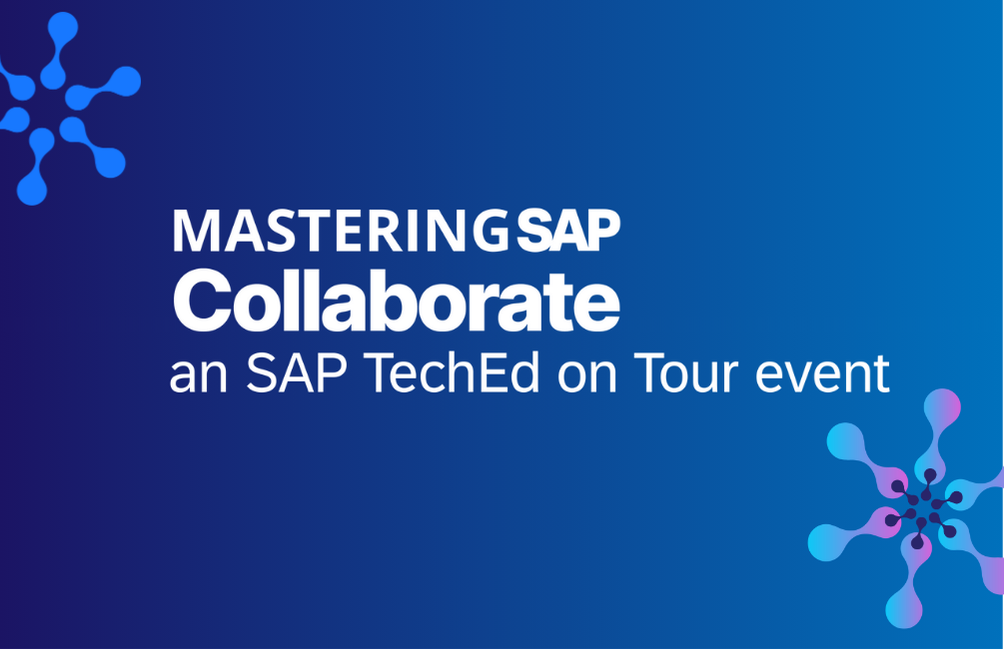SAP Digital Manufacturing Cloud
Filter By
Browse By
- SAP Analytics and AI
- SAP Application Development and Integration
- All SAP Application Development and Integration
- SAP ABAP
- SAP ABAP Development Tools
- SAP ABAP Test Cockpit
- SAP API Management
- SAP BAPI
- SAP Basis
- SAP BRF
- SAP Business Application Studio
- SAP CMS
- SAP Design Studio
- SAP Development Tools
- SAP DevOps
- SAP EAI
- SAP EDI
- SAP Extension Suite
- SAP Fiori
- SAP Fiori Elements
- SAP Integration Suite
- SAP Low Code Application Development
- SAP Low Code Automation
- SAP Netweaver
- SAP Release Management
- SAP UI5
- SAP Web Application Server
- SAP Web IDE
- SAP Business Process Management
- SAP Center of Excellence
- SAP CIO
- SAP Customer Experience
- SAP Data and Data Management
- All SAP Data and Data Management
- SAP BW
- SAP BW/4HANA
- SAP Crystal Reporting
- SAP Data Archiving
- SAP Data Center
- SAP Data Governance
- SAP Data Integration
- SAP Data Migration
- SAP Data Quality
- SAP Data Services
- SAP Data Strategy
- SAP Data Visualization
- SAP Data Warehouse Cloud
- SAP DMS
- SAP Document Control
- SAP EIM
- SAP ETL
- SAP ETL Tools
- SAP HANA
- SAP HANA Administration
- SAP HANA Deployment Infrastructure
- SAP HANA Studio
- SAP Master Data
- SAP Master Data Governance
- SAP MDM
- SAP Enterprise Architect
- SAP Enterprise Asset Management
- SAP ERP
- SAP Finance
- All SAP Finance
- SAP Accounting
- SAP AR AP
- SAP Asset Accounting
- SAP Billing Systems
- SAP BPC
- SAP BRIM
- SAP Cash Management
- SAP Central Finance
- SAP Controlling
- SAP COPA
- SAP Cost Center Accounting
- SAP e-invoicing
- SAP FICO
- SAP Finance Automation
- SAP Financial Closing Cockpit
- SAP Financial Consolidation
- SAP Financial Planning
- SAP FX Risk
- SAP General Ledger
- SAP Global Tax Management
- SAP Hyperion
- SAP Order to Cash
- SAP Payment Processing
- SAP Profitability Analysis
- SAP Rebate Management
- SAP S/4HANA Finance
- SAP Universal Journal
- SAP Governance Risk and Compliance
- SAP Human Capital Management
- SAP Intelligent Technologies
- SAP Platform and Technology
- All SAP Platform and Technology
- SAP Business Technology Platform
- SAP Cloud Connector
- SAP Cloud Integration Platform
- SAP Cloud Migration
- SAP Cloud Platform
- SAP Cloud Providers
- SAP Cloud Strategy
- SAP Container Platform
- SAP Digital Asset Management
- SAP Digital Integration Hub
- SAP Digital Signature
- SAP HANA Enterprise Cloud
- SAP HEC
- SAP Hyperscalers
- SAP Infrastructure
- SAP Messaging
- SAP Smart Forms
- SAP Quality and Testing
- SAP Security
- SAP Spend Management
- SAP Supply Chain Management
- All SAP Supply Chain Management
- SAP APO
- SAP Asset Management
- SAP Business Network
- SAP Digital Manufacturing Cloud
- SAP Digital Twin
- SAP EWM
- SAP IBP
- SAP Inventory Management
- SAP Label Printing
- SAP Logistics
- SAP Manufacturing
- SAP Manufacturing Automation
- SAP MES
- SAP MII
- SAP MM
- SAP MRO
- SAP MRP
- SAP Order Management
- SAP Plant Maintenance
- SAP PLM
- SAP Production Planning
- SAP S&OP
- SAP SD
- SAP SPM
- SAP Supply Chain Planning
- SAP Track and Trace
- SAP Transportation Management
- SAP System Administration
SAP Supply Chain: Digital Manufacturing Cloud
Market trends are driving changes within manufacturing. It is more important than ever to explore new opportunities with automation and flexible operations for enhanced productivity.
Digital Manufacturing Cloud Defined
Digital manufacturing cloud (DMC) is a cloud-based manufacturing execution system providing a relationship between production and business within supply chain management. It provides the ability to access software from any web browser. DMC optimizes manufacturing performance with integrated production execution, greater visibility, and analysis to meet the high demands of today’s market. By integrating manufacturing and business systems, cost effective and high-quality resources can be used. Some core characteristics are the intuitive user interfaces and modern process-orientated features.
Features include:
- Cloud deployment
- Visibility across the top floor and shop floor
- Key performance indicators and analytics
- Detailed execution of production processes.
Leveraging data helps with performance monitoring. It can detect production-related issues and help trace issues to the root cause, enabling manufacturing operations to be more efficient and scalable. The ability to share information in real time and use advanced analytics to support decision-making is a game changer. It allows traceability, increasing both efficiency and scalability.
SAP Supply Chain: Digital Manufacturing Cloud
Market trends are driving changes within manufacturing. It is more important than ever to explore new opportunities with automation and flexible operations for enhanced productivity.
Digital Manufacturing Cloud Defined
Digital manufacturing cloud (DMC) is a cloud-based manufacturing execution system providing a relationship between production and business within supply chain management. It provides the ability to access software from any web browser. DMC optimizes manufacturing performance with integrated production execution, greater visibility, and analysis to meet the high demands of today’s market. By integrating manufacturing and business systems, cost effective and high-quality resources can be used. Some core characteristics are the intuitive user interfaces and modern process-orientated features.
Features include:
- Cloud deployment
- Visibility across the top floor and shop floor
- Key performance indicators and analytics
- Detailed execution of production processes.
Leveraging data helps with performance monitoring. It can detect production-related issues and help trace issues to the root cause, enabling manufacturing operations to be more efficient and scalable. The ability to share information in real time and use advanced analytics to support decision-making is a game changer. It allows traceability, increasing both efficiency and scalability.
Key capabilities are:
- Harmonized data analytics
- Unified manufacturing modeling
- Integrated manufacturing operations management.
Benefits are:
- Empowered stakeholders to track root causes and enhance manufacturing performance
- Data integration of multiple systems improves visibility and analytics
- Advanced algorithms though machine learning allows root cause analysis for faster insights
- Transparent visibility of production manufacturing to access quality or production issues and reduce risk
- Individualized requirements to improve customer satisfaction
- Optimized use of resources to improve quality and minimize down time.
A solution suite comes with different modules. Organizations can choose the right fit based on their size and industry type. For example, SAP offers DMC for Execution to control the shop floor, while DMC for Insights focuses on performance management and predictive quality across plant locations.
Vendor partners to modernize your digital solution to increase efficiency are: SAP, Accenture, or NTT Data Business Solutions.
Key Considerations for SAPinsiders
- SAP Workloads are Moving to the Cloud. Robert Holland shares his insights on business drivers behind the transformation into the cloud.
- Evolve your Manufacturing Execution System (MES) into a Digital Twin — in the Cloud. Kumar Singh shares this article explaining what a manufacturing execution system is.
- Optimize your Manufacturing Plant by Implementing an MES for Shop Floor Data Collection and Automatic Data Transfer to ECC. Sasa Mitrovic at Summit Global Associates shares insights for common use cases and best practices during implementation.
8 results
-

Carl Zeiss AG tech leader talks up being first for SAP cloud-based manufacturing
Published: 16/May/2024
Reading time: 2 mins
A top IT executive at German optical systems and optoelectronics giant Zeiss Group was in Australia in May to meet with fellow SAP customers. Jochen Scheuerer, Head of Connected Smart Factory at Zeiss Group’s holding company Carl Zeiss AG, shared Carl Zeiss AG’s journey with SAP Digital Manufacturing (SAP DM) with other SAP customers in…
-

- SAP Digital Manufacturing Cloud
 Premium
Premium
Achieving a Holistic Design & Manufacturing Vision – The Fujitsu Way
Click HERE to view the presentation deck slides. Fujitsu’s Holistic Value Chain Management vision leverages SAP Digital Manufacturing to drive Sustainable Manufacturing, it includes an end-to-end view of Design & Manufacturing, extending on SAP’s Design to Operate concept, Fujitsu’s solution includes ESG at its core, and extends deep into GHG Visualization and Reduction (SAP ESG)....…
-

SAP Digital Manufacturing Cloud
Published: 02/March/2023
Reading time: 1 min
Integrate business systems to the shop floor and improve the visibility, and analysis for the global operations. Register below and download the One Pager SAP Cloud Manufacturing Solutions provided by Fujitsu.
-
-

How Federal Mogul Migrated to ERP in the Cloud
Published: 09/November/2022
Reading time: 1 mins
Amid increasing volatility and uncertainty in the market, Federal Mogul recognized it needed more agility and flexibility to meet fast-changing customer needs. To get there, Federal Mogul committed to a cloud-first digital transformation. Its strategy involved digitalizing its manufacturing execution system and migrating its on-premise business landscape to advanced ERP in the cloud.
-

Responsive Manufacturing: Redefining the Digital Enterprise
Published: 04/August/2016
Reading time: 6 mins
Customers in the digital age are demanding more: more customization, more control over their purchases, and more guarantees of immediacy. To meet these demands, manufacturers must do more to become flexible and responsive. This means leveraging the Internet of Things (IoT) to enable digital manufacturing processes and gather actionable insights about asset performance. Discover strategies…
-

Live from SAPinsider Studio: Mike Lackey on the Evolving Nature of Manufacturing
Mike Lackey, Global VP of Solution Management for LoB Manufacturing at SAP, joins SAPinsider Studio at the SAP SCM 2016 event to discuss how IoT and digital business is transforming the nature of manufacturing. Natalie Miller, SAPinsider: Hi, I’m Natalie Miller with SAPinsider and we’re at the SCM, CRM, and IoT event in Las Vegas…
-

How SAP S/4HANA Enables Digital Transformation in Supply Chain and Manufacturing
Published: 26/April/2016
Reading time: 6 mins
The digital transformation is revolutionizing every line of business, and with more products and services available than ever before, the supply chain is a key front for these revolutionary changes. Consumers want their products customized and delivered quickly, which in turn requires supply chains to be agile, fast and flexible. And these capabilities, in turn,…
-
-

Tips for Mapping Physical Production Operations to the Optimal Manufacturing Type in SAP ECC
Published: 22/October/2013
Reading time: 16 mins
Management The requirement to integrate your SAP system with a shop floor system can have a profound impact on which manufacturing type you adopt. Learn the characteristics of each manufacturing type in an SAP system and the master data and transactional steps required to implement each in SAP ERP Central Component (ECC). View a decision...…
Become a Member
Unlimited access to thousands of resources for SAP-specific expertise that can only be found here.
Upcoming Events
-

Mastering SAP Collaborate an SAP TechEd on Tour event
November 12 - 14, 2025
Sydney, New South Wales
Australia
View Event
Related Vendors
Your request has been successfully sent

